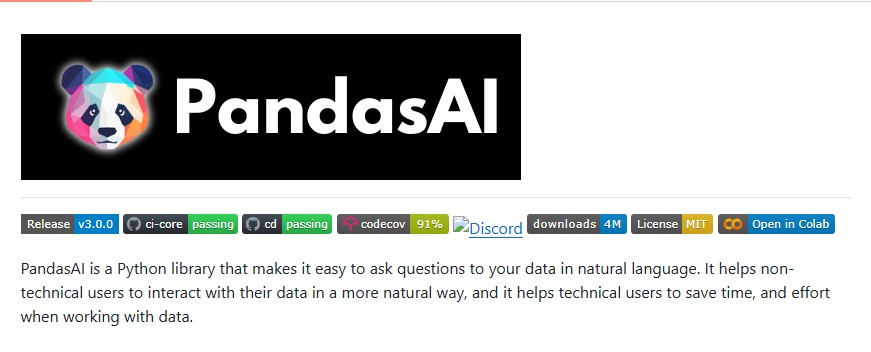In a world dominated by data, the ability to analyze and interpret information efficiently has become a core competitive advantage. From business intelligence dashboards to large-scale machine learning models, data-driven decision-making fuels innovation across industries. Yet, for most people, data analysis remains a technical challenge requiring coding expertise, statistical knowledge and familiarity with libraries like Pandas or NumPy.

Enter PandasAI, an open-source Python library developed by Sinaptik AI that’s changing how we interact with data. With PandasAI, anyone whether technical or non-technical can ask questions about their datasets in natural language and the AI does the rest. It’s like having a data scientist powered by GPT-4 sitting right inside your Python environment.
What Is PandasAI?
PandasAI is an intelligent extension of the popular Python library Pandas designed to make data analysis conversational and accessible. Instead of writing lines of complex code, users can simply type questions like:
“What is the average revenue by region?”
“Show me a chart of sales by country.”
“Which employees have the highest salaries?”
The library interprets these questions using a large language model (LLM) such as GPT-4.1-mini executes the necessary data operations and returns clear, accurate results often accompanied by visualizations.
This seamless blend of natural language processing (NLP) and data science eliminates technical barriers, helping business users, analysts and researchers explore their data intuitively.
Why PandasAI Is a Game-Changer ?
Traditional data analysis requires knowledge of Python syntax, dataframes and plotting libraries like Matplotlib or Seaborn. While these tools are powerful, they aren’t user-friendly for non-programmers.
PandasAI bridges that gap by introducing a conversational layer over structured and unstructured datasets. Whether you’re analyzing a CSV, a SQL database or a data lake, you can now query, visualize and interpret data using plain English.
Key benefits include:
- Accessibility: Non-technical users can analyze data without coding.
- Speed: Reduces analysis time from hours to seconds.
- Consistency: Ensures accurate and reproducible insights.
- Scalability: Works across local files, databases, and cloud data sources.
- Security: Supports sandboxed environments to prevent malicious code execution.
How PandasAI Works ?
At its core, PandasAI connects your dataframes to a large language model (LLM). The process is simple and intuitive:
1. Install PandasAI
PandasAI supports Python 3.8 to 3.11 and can be installed using pip or poetry:
pip install pandasai pip install pandasai-litellm
2. Initialize the LLM
The library uses LiteLLM as a bridge to GPT-based models:
from pandasai_litellm.litellm import LiteLLM llm = LiteLLM(model="gpt-4.1-mini", api_key="YOUR_OPENAI_API_KEY")
3. Load and Query Data
You can load data directly into PandasAI:
import pandasai as pai
pai.config.set({"llm": llm})
df = pai.read_csv("data/companies.csv")
response = df.chat("What is the average revenue by region?")
print(response)
And just like that, PandasAI interprets your query, processes the data, and returns the answer — no code required.
Visualizing Data with AI
It doesn’t stop at text-based responses. You can generate charts and graphs automatically with natural language commands.
For instance:
df.chat("Plot a histogram of countries showing GDP, using different colors for each bar.")
The AI understands the request, creates a data visualization, and renders it instantly. This capability is invaluable for analysts who want quick, visual insights without switching between multiple tools.
Multi-DataFrame Support
Real-world data analysis often involves working with multiple datasets. It seamlessly handles cross-dataframe queries, allowing users to ask questions that involve relationships between tables — much like SQL joins but in plain English.
Example:
pai.chat("Who gets paid the most?", employees_df, salaries_df)
Output:
Olivia gets paid the most.
This feature makes it possible to perform advanced analytics across departments, teams or entire data pipelines without writing a single line of code.
Enhanced Security with Docker Sandbox
Running AI code can introduce security risks, especially when working with sensitive data. It addresses this through its Docker Sandbox environment — a secure, isolated container that prevents unauthorized or harmful operations.
You can easily activate it:
from pandasai_docker import DockerSandbox
sandbox = DockerSandbox()
sandbox.start()
pai.chat("Who gets paid the most?", employees_df, salaries_df, sandbox=sandbox)
sandbox.stop()
This ensures every command is executed safely, making PandasAI suitable for enterprise and regulated environments.
Who Can Benefit from PandasAI?
PandasAI’s versatility makes it ideal for a wide range of users and industries:
- Data Analysts: Speed up exploratory data analysis (EDA).
- Business Teams: Extract insights from CSVs and dashboards.
- Researchers: Query large datasets without coding overhead.
- Startups: Prototype analytics solutions rapidly.
- Educators: Teach data analysis interactively.
In short, anyone who deals with data can leverage PandasAI to enhance productivity and insight generation.
Open Source and Enterprise Options
It is fully open-source under the MIT License, allowing developers to integrate or modify it freely. The team at Sinaptik AI also offers PandasAI Cloud and Enterprise solutions for organizations that require managed hosting, scalability and enterprise-grade security.
The library is actively maintained with over 22,000 GitHub stars, 2,200 forks and a thriving community of 120+ contributors. You can explore detailed documentation, examples, and tutorials directly from the official GitHub repository.
Conclusion
In an era where AI is transforming how we work, PandasAI is revolutionizing how we understand data. By combining the power of large language models with the flexibility of Pandas, it democratizes data analytics allowing anyone to chat with their data, uncover insights and make smarter decisions instantly.
Whether you’re analyzing financial reports, visualizing customer trends, or querying massive databases, PandasAI turns your data into a dialogue. It’s not just a tool — it’s a glimpse into the future of AI-driven analytics.
Follow us for cutting-edge updates in AI & explore the world of LLMs, deep learning, NLP and AI agents with us.
Related Reads
- Agent Lightning By Microsoft: Reinforcement Learning Framework to Train Any AI Agent
- Free for 1 Year: ChatGPT Go’s Big Move in India
- Reinforcement Learning for Large Language Models: A Complete Guide from Foundations to Frontiers Arun Shankar, AI Engineer at Google
- AI Projects : A Comprehensive Showcase of Machine Learning, Deep Learning and Generative AI
- LangExtract by Google: Transforming Unstructured Text into Structured Data with LLM Precision

4 thoughts on “PandasAI: Transforming Data Analysis with Conversational Artificial Intelligence”